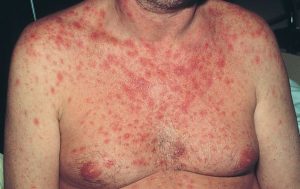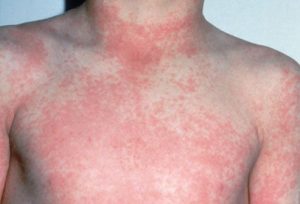How to Identify HIV Rash
Identifying an HIV rash can be challenging because rashes can be caused by a wide range of factors, and not everyone with HIV will develop a rash. Additionally, the appearance of an HIV rash can vary from person to person. However, there are some general characteristics and factors to consider:
- Timing: An HIV rash typically appears within the first few weeks to months after initial infection. It can be an early sign of HIV, but not everyone with HIV will develop a rash. Read about Congestive Heart Failure Leg Cramps
- Location: HIV rashes can occur on various parts of the body but are commonly found on the trunk (chest and back) and sometimes on the arms and face.

- Appearance: An HIV rash may present as flat or slightly raised red or pink spots, and it may be itchy. The rash can resemble other skin conditions, such as eczema, heat rash, or allergic reactions. Discover about Where Can I Get Tested for STDs
- Distribution: The rash can be widespread or limited to specific areas. It may cover a large surface area or only affect small patches of skin.
- Persistence: Unlike some other rashes that come and go quickly, an HIV rash may persist for an extended period, often for several weeks.
- Fever and Other Symptoms: Along with the rash, individuals with acute HIV infection may experience other symptoms like fever, sore throat, fatigue, swollen lymph nodes, and muscle aches. These symptoms may help differentiate an HIV rash from other common skin conditions.
- Risk Factors: Consider your risk factors for HIV. If you engage in high-risk behaviors or have had unprotected sex with a partner whose HIV status is unknown, it’s essential to consider the possibility of HIV if you develop a rash or experience other symptoms.
It’s important to note that an HIV rash is not a definitive indicator of HIV infection. Many other conditions can cause skin rashes, so a rash alone is not sufficient for diagnosis.
Also read the Article: What Kind of Doctor Treats Fibromyalgia
Understanding HIV and Its Early Symptoms
What is HIV?
HIV is a virus that attacks the immune system, specifically the CD4 cells (T cells), which help the immune system fight off infections. If left untreated, HIV can lead to the disease AIDS (Acquired Immunodeficiency Syndrome).
Early Symptoms of HIV
How to Identify HIV early is vital for effective management and prevention. Early symptoms may include:
Fever
A persistent low-grade fever may occur within a few weeks after HIV infection.
Fatigue
Unexplained and prolonged fatigue is a common early symptom of HIV.
Swollen Lymph Nodes
Lymph nodes, particularly in the neck, armpit, or groin, may become swollen.
Sore Throat
A persistent sore throat may be one of the early signs.
The Role of HIV Rash
How to Identify HIV Rash is another possible early symptom, and it can be perplexing. Let’s delve into the specifics of this rash:

Identifying HIV Rash
What Does an HIV Rash Look Like?
HIV rash typically:
Appears Red
The rash often presents as small, red bumps or pimples.
Spreads Across the Body
It can spread across the body, including the face, chest, and limbs.
Is Itchy
The rash is usually itchy, causing discomfort.
Resolves on Its Own
How to Identify HIV rash usually resolves within a few weeks.
How to Differentiate It from Other Rashes
HIV rash can be bursty, but it’s essential not to confuse it with other rashes. Consult a healthcare professional for an accurate diagnosis.
Preventing HIV Rash
Importance of Early Detection
Early detection of HIV is crucial. Regular testing can help identify the virus before symptoms, including the rash, appear.
Safe Practices
Engaging in safe sexual practices, such as using condoms, can significantly reduce the risk of HIV infection.
Education and Awareness:
Educating oneself and others about HIV and its symptoms is essential for prevention.
Understanding HIV Testing
When Should You Get Tested?
It’s advisable to get an HIV test if you’ve engaged in unprotected sex, shared needles, or had sexual contact with a partner whose HIV status is unknown. Regular testing is also recommended if you are at a higher risk, such as through multiple sexual partners or drug use.
Types of HIV Tests
HIV tests include blood tests, oral swabs, and rapid tests. Your healthcare provider can help you choose the most appropriate test for your situation.
Window Period
Keep in mind that there is a window period between HIV infection and when it can be detected by a test. This period can vary, but most tests can detect HIV within a few weeks to a few months after infection. Consult a healthcare professional for guidance on when to test.
Living with HIV
Antiretroviral Therapy (ART)
If you are diagnosed with HIV, don’t lose hope. Antiretroviral therapy (ART) is the primary treatment for HIV. It helps suppress the virus, allowing you to live a long and healthy life.
HIV Support Services
Seek out HIV support services and organizations that can provide information, counseling, and assistance with managing your condition.
Reducing Stigma
HIV-related stigma remains a significant issue. Education and open conversations about HIV can help reduce stigma and discrimination.
Conclusion
How to Identify HIV Rash is a crucial step in recognizing early HIV infection. Remember that HIV is a manageable condition, and early detection is key to living a healthy life. If you suspect you may have HIV or experience any symptoms, consult a healthcare professional for testing and guidance.
FAQs
1. Can an HIV rash be painful?
HIV rash is typically itchy but not painful. If you experience pain, consult a healthcare provider.
2. Is an HIV rash always present in early infection?
No, not everyone with HIV will develop a rash. It’s one of the possible symptoms but not a definitive indicator.
3. How accurate are HIV tests?
Modern HIV tests are highly accurate. A healthcare provider can recommend the most suitable test for your situation.
4. Can HIV be cured?
Currently, there is no cure for HIV, but it can be effectively managed with antiretroviral therapy.
5. Is HIV transmitted through casual contact?
No, HIV is primarily transmitted through unprotected sex, sharing needles, or from mother to child during childbirth or breastfeeding.
